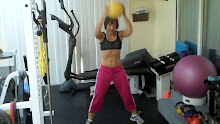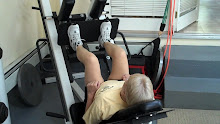Finding the Size That’s Right For You
This table summarizes the general ball size appropriate for your height and how tall it is (the diameter) when it’s fully inflated.

Please keep in mind that this is only a guideline it really depends on the individual and your leg length. I’m 5’11” and I feel more comfortable with the 55 cm. A better way to get the fit that’s best is that when you are sitting on the ball, your legs should be at a 90-degree angle with your thighs parallel to the floor and your hips at the same height as your knees. However, there are some exercises you may do where a smaller ball might work better; if this applies to you, then you might want to consider having two balls of different size.
For balance, a firmer ball will be more difficult to balance on, so seniors or beginners should consider using a larger, softer ball. And no the ball is not going to explode; it holds me so you’re safe. Actually it supports over 600 pounds.
Typically, the stability balls you will find in most stores are 65 cm; however sometimes you can find a 55 cm ball. If the store nearest you does not have the proper size, try going to a sporting goods store or performbetter.com; they are likely to have a wider variety of sizes.
Most folks assume a SB is only used for core. Yes it’s great for core exercises but don’t limit yourself, its full body. It’s great for most exercises for a change of pace.
If you’re a beginner be careful. Start off with just lying on the ball and getting on and off. Start off with basic crunches and chest presses before you progress to the advanced stuff.
Should you use them? Yes. Sitting or lying on a stability ball helps strengthen your core--no matter which muscle groups you're working.
Crunch
Start by sitting on the exercise ball as if you were sitting on a chair. Slowly lean back and walk your feet forward until the ball is positioned on your lower back region and you are looking toward the ceiling. The top your legs should be parallel to the floor.
Cross your hands on your chest and keep your head in a neutral position looking forward (toward the ceiling). Your chin should not touch your chest at any point
Here are a few great examples for advanced folks:
Pike
Begin in a push-up position with your shins on top of the exercise ball.
Keeping your legs as stiff as possible, use your abs to roll the ball forward, lifting your hips toward the ceiling.
Hold this position for a three count while flexing your abdominal muscles.
Slowly return to the beginning position.
Note: To make easier place the ball closer to your knees.

Push Up with Hands on the Floor
Start by positioning yourself in the standard push-up position, with your hands slightly wider than shoulder width. Place your feet on top of your exercise ball.
Slowly lower yourself to the ground until your chest nearly contacts the floor.
Perform a push-up by pressing yourself from the floor back to the position number 1 (the starting position).
Note: If you are a beginner, place the ball under your thighs in step 1. The closer the ball is placed to your feet, the harder it is to complete the exercise.

Back Extension
Begin by kneeling on the floor in front of stability ball and lie face down so that the ball is at your upper abdominal region. Your head should be facing the floor.
Cross your hands over your chest, and raise your torso approximately six inches.
Hold for a count, then slowly and under control, lower your torso to the starting position.
Note: The further the ball is placed toward your hips, the harder the exercise is to perform.
Note: You can add further resistance by holding weights in your arms as you perform this exercise.







.jpg)



